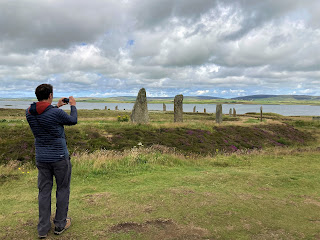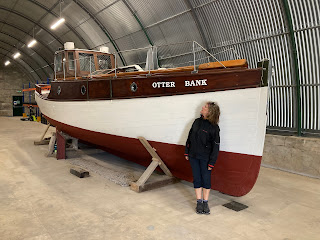We returned from Hoy to spend some time on the west of the mainland to visit some archaeological sites. We have demounted and stayed for a while at Stromness.
 |
| The hills of Hoy in the background |
Scara Brae is one of the most well known Neolithic sites, although in our opinion, not as interesting as Jarshof in Shetland. Also, here we had to follow a route around the edge, while at Jarshof we could explore how we liked inside the ruins. |
| That is a stone age shelf unit! |
 |
5000 years old stone carving - so well made!
No-one knows what it is. |
 |
| He doesn't look too happy! |
There has been an archaeological dig on the Ness of Brodgar since 2004 after a notched stone was uncovered when ploughing, which unearthed a massive settlement. They think less than 10% has been excavated but this will finish next year when it will be filled in to preserved for future generations. |
We had a guided tour by one of the
archaeologists on site |
Nearby was the Ring of Brodgar, a very impressive stone circle.
During the second world war the standing stones, with their outer ditch, proved a great training ground for tanks! Not sure how many stones they knocked down!
Maeshowe is a well preserved chambered cairn. We had to book on a guided trip to get in and you cannot take photos inside. All these cairns involve crawling through a tunnel to get in - and once inside they are surprisingly large - you can stand up and walk around - the roof is very high.
 |
| There are some trees in Orkney! |
 |
| Standing Stones of Stenness |
Some cairns are just open and you can go straight in - there is usually a torch in a locker outside. This one at Cuween Hill had a particularly low, narrow passage to get inside.
 |
A large number of dog skulls
were found inside this cairn |
 |
| Impressive sea stack at Yesnaby |
 |
| The Kitchener memorial at Marwick Head |
There are some lovely hikes around the coastal cliffs. One of them takes you to the Kitchener memorial. Lord Kitchener (secretary of state for war) is the man on the 1st world war "Your Country Needs You" posters. He was on a ship going to Russia in 1916, which was hit by a mine laid by a German U-boat. Kitchener died and there were 12 survivors out of 749 on board.
We were in Stromness during their "Shopping Week", which is actually a week festival of events. The carnival had a very unusual parade of floats having to negotiate the narrow streets! The difference was that they were taking the p**s out of various subjects like Pentland Ferries (breaking down), something about Phillip Schofield, Love Island (??) and the film release Barbie. Lots of men dressed as women and drunken antics! Not very PC!
On another evening there was a raft race which was actually quite a distance. One sank at the beginning but all the others made it. The sunken boat was refloated and with two less paddlers came close.
We also stumbled across the Royal Mail testing a drone for delivering parcels up to about 4 or 5 kg to nearby islands. Interesting but sad that the local human connection will soon be lost.
We had learned at the museum in Hoy how the captured German fleet was scuttled by its crew in Scapa Flow at the end of the First World War, so this pub mat made us laugh!
We have been in Stromness for quite a while now - John, the campsite warden, said we will be locals soon! The walks from here are lovely and we have a little jetty to swim from about 10 steps from us. Stromness is a friendly place that we are enjoying being based at.



































































